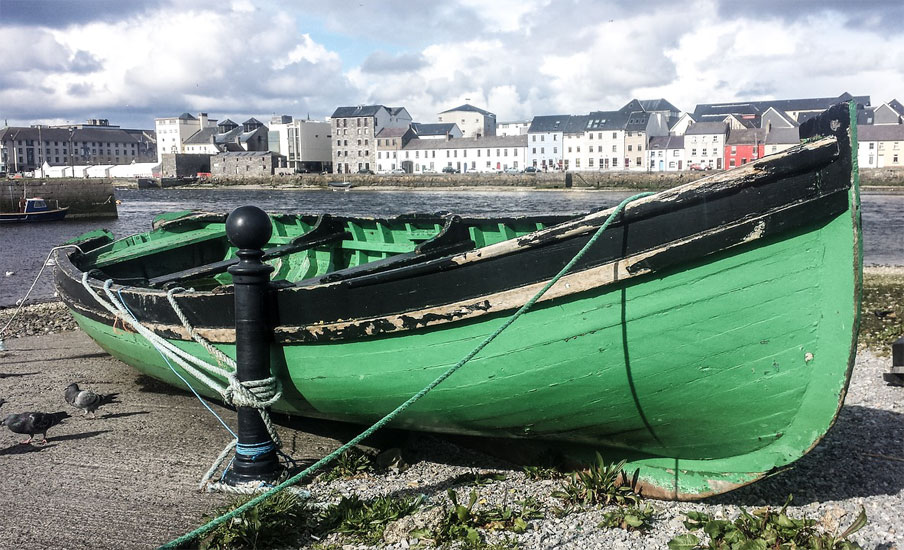Galway is the capital of the county of Galway in the province of Connacht in the Republic of Ireland.
It is located at the confluence of the Corib River and the Atlantic Ocean. It is the third most populous city in the country after the capitals of Dublin and Cork. Galway is known as the Cultural Heart of Ireland and is known for its lifestyle and numerous festivals and festivals. Golgotha has been chosen as the European Capital of Culture for 2020, along with Rijeka, Croatia.
Access : Coordinates: 53.271944, -9.048889 / By plane
Ireland West Airport Knock (IATA code: NOC) is 90 km north of Galway with various daily connections to Great Britain. In summer, Lufthansa flies to Knock once a week. – Travel time by car 1 hour and 20 minutes. 2 hours by bus. Otherwise, landing in Dublin
/ By ship and car :
The easiest way to get there is via the ports at and in Dublin. There are continuous highways from there for the onward journey to Galway. Travel time: 2 to 3 hours. Galway is on the Wild Atlantic Way tourist street. / By train :
There are connections from the 1 Train Station to Dublin Heuston Station (just under 3 hours) and – with a change in Athenry – to Limerick./
By bus :
A popular way to travel in Ireland without a car is to use the Bus Eireann network.
Highlights :
- Lynch Castle : Lynch Castle is an example of Irish Gothic. Located between Shop Street and Abbeygate Street, the castle belonged to one of the most powerful Irish families. The exact date of the beginning of the construction of the castle is unknown, but a number of features indicate the end of the 15th – beginning of the 16th centuries. In 1930, it was acquired by the Union of Irish Banks and restored. The first floor of the castle is open for visitors.
- Salthil : Salthill is the entertainment district of Galway. Alongside the bathing beach, there are hotels and pubs, in particular amusement arcades and night clubs.
- Salmon Weir Bridge : The Salmon Weir Bridge crosses the Corrib River between the courthouse and the cathedral. From mid-April to July you can see schools of salmon fish on their way up the Corrib River.
- Cathedral of the Assumption and St. Nicholas The Catholic bishop’s church, completed in 1965 with a distinctive dome, almost bankrupted the city when it was built. The architecture of the building is controversial, as is the former bishop Eamon Casey.
- The Hall of the Red Earl : the earliest medieval structure to be seen within the walls of the city. / The Claddagh is the oldest part of Galway / The Lynch Window, (on Market Street), commemorates one of the city’s most enduring legends. / Eglinton Canal, named after a former Lord Lieutenant of Ireland / The remains of Menlo Castle /
- Collegiate Church of St. Nicholas (Eaglais Cholaisteach San Nioclas) The Anglican church today is the largest continuously used medieval parish church in Ireland and was founded in 1320 in honor of the patron saint of sailors and merchants, St. Santa Claus
- Archway, Blake’s Castle In the harbor, near the city center, the visitor will find a memorial stone on which it is said that Christopher Columbus, Genoese sailor, got the tip here to sail west.
- Galway has a large number of pubs typical of Ireland. Many of them offer live music daily or at least regularly, from traditional Irish music to modern pop.
- The Galway City Museum is located at the Spanish Arch.It presents the rich archaeology, monuments and history of the city in several exhibitions.
- Right on the Corrib River is the Fishery Watchtower Museum, a mid-19th century building. In 1999 it was officially opened as a museum.
- In Galway, an annual horse racing festival takes place, which has gained worldwide fame. Read more on the website of The Galway Races festival.
- The town square is located near the train station and has been redesigned in recent years and completed in early 2006.
- Claddagh ring : The Claddagh is a former fishing settlement located beyond the Corrib. This can still be seen in the striking buildings with largely small, one-and-a-half-story houses, which stand out clearly from the surroundings.The Claddagh Ring, a friendship ring in which two hands hold a heart with a crown, is known beyond Galway’s borders. This ring can be found in Galway jewelry stores.
- Spanish Arch: Spanish Arch. Built in 1584, it is located near the river and is thought to have been an extension of the ancient walls of Galway which served as a passageway for ships that had to unload goods, mostly wine and brandy from Spain.
Events : In May, the annual Early Music Festival (Galway Early Music, website) takes place./ Galway Arts Festival, website, the leading art festival in Ireland with more than 30 years of history. It is one of the key cultural events in Europe.
/ The Cuarth Millennium music festival takes place every 3rd September.
Activities : sightseeing / photo opportunities / trekking – Walk: Stroll along the banks of the River Corrib and the Eglington Canal, / Shopping in Galway
Galway’s main shopping street starts from Eyre Square and further south towards the Corrib River.
Go next : The Aran Islands are located in Galway Bay, You can get to these islands by ferries / across Galway Bay is County Clare, and the spare limestone terrain of The Burren, which meets the Atlantic at the Cliffs of Moher

